计算机网络介绍中英文
- 格式:doc
- 大小:176.00 KB
- 文档页数:11

ATM:Asynchronous Transfer Mode异步传输模式CDMA:Code Division Multiple Access码分多路访问VPN:Virtual Private Networks虚拟私有网络MAC:Medium Access Control介质访问控制WWW:World Wide Web万维网GPS: global positioning protocol 全球定位系统DNS:Domain Name System域名系统W AP:wireless application protocol 个域网LAN:Local Area Network局域网VLAN:Virtual Local Area Network虚拟局域网MAN:metropolitan area network 城域网W AN:wild area network 广域网WLAN: wireless local area network 无线局域网FDM:Frequency Division Multiplexing,频分多路复用TDM:Time Division Multiplexing,时分多路复用OSI/RM: Open Systems Interconnection Reference Model,开放系统互连参考模型ISO:international standards organization 国际标准化组织FTP:File Transfer Protocol,文件传输协议HTTP:Hyper Text Transfer Protocol,超文本传输协议TCP:Transmission Control Protocol,传输控制协议UDP:User Datagram Protocol,用户数据报协议SMTP:Simple Mail Transfer Protocol,简单邮件传输协ICMP:Internet Control Message Protocol,Internet控制消息协议IGP:Interior Gateway Protocol,内部网关协议IP:Internet Protocol,网络互联协议SONET:Synchronous Optical NETwork,同步光网络PPP:Point-to-Point Protocol,点到点协议RTP:Real-time Transport Protocol,实时传输协议RARP:Reverse Address Resolution Protocol,反向地址解析协议SAP:Service Access Point,服务访问点VC:Virtual Circuit,虚电路V oIP:V oice over IP,IP语音CRC :Cyclic Redundancy Check,循环冗余校验码Pop: point of presentDSL:digital subscriber line。

英文作文介绍网络英文:The internet is a vast network of interconnected computers and servers that allows people from all over the world to communicate and share information. It has revolutionized the way we live, work, and interact with each other. With just a few clicks, we can access an endless amount of information, connect with friends and family, buy and sell goods and services, and even work remotely.One of the biggest advantages of the internet is its convenience. We can do almost anything online, from shopping to banking to booking travel arrangements. We can also connect with people from all over the world, regardless of distance or time zone. Social media platforms like Facebook and Twitter have made it easy to stay in touch with friends and family, while also allowing us to meet new people and form new connections.However, the internet also has its drawbacks. With so much information available, it can be difficult to separate fact from fiction. It's important to be critical of the sources we use and to fact-check information before sharing it with others. Additionally, the internet can be a breeding ground for cyberbullying and online harassment, which can have serious consequences for those affected.Despite its flaws, I believe that the internet has had a largely positive impact on our lives. It has made the world a smaller, more connected place, and has opened up opportunities for people that were once unimaginable. As long as we use it responsibly and with caution, theinternet will continue to be an invaluable tool for communication, learning, and growth.中文:互联网是一个庞大的互联计算机和服务器网络,使来自世界各地的人们能够相互交流和分享信息。
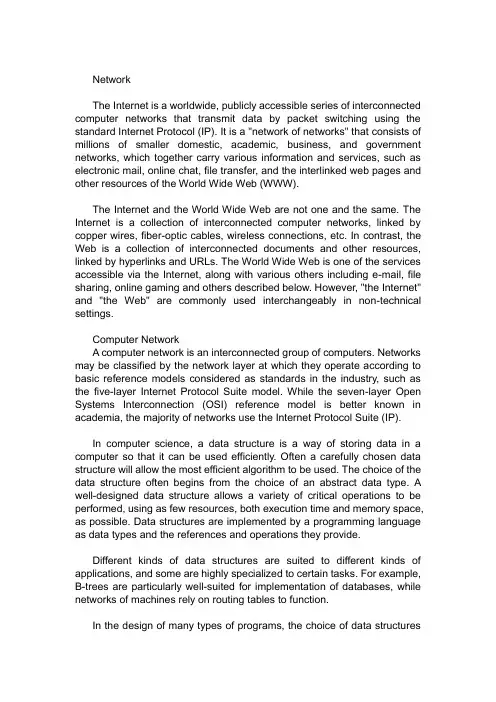
NetworkThe Internet is a worldwide, publicly accessible series of interconnected computer networks that transmit data by packet switching using the standard Internet Protocol (IP). It is a "network of networks" that consists of millions of smaller domestic, academic, business, and government networks, which together carry various information and services, such as electronic mail, online chat, file transfer, and the interlinked web pages a nd other resources of the World Wide Web (WWW).The Internet and the World Wide Web are not one and the same. The Internet is a collection of interconnected computer networks, linked by copper wires, fiber-optic cables, wireless connections, etc. In contrast, the Web is a collection of interconnected documents and other resources, linked by hyperlinks and URLs. The World Wide Web is one of the services accessible via the Internet, along with various others including e-mail, file sharing, online gaming and others described below. However, "the Internet" and "the Web" are commonly used interchangeably in non-technical settings.Computer NetworkA computer network is an interconnected group of computers. Networks may be classified by the network layer at which they operate according to basic reference models considered as standards in the industry, such as the five-layer Internet Protocol Suite model. While the seven-layer Open Systems Interconnection (OSI) reference model is better known in academia, the majority of networks use the Internet Protocol Suite (IP).In computer science, a data structure is a way of storing data in a computer so that it can be used efficiently. Often a carefully chosen data structure will allow the most efficient algorithm to be used. The choice of the data structure often begins from the choice of an abstract data type. A well-designed data structure allows a variety of critical operations to be performed, using as few resources, both execution time and memory space, as possible. Data structures are implemented by a programming language as data types and the references and operations they provide.Different kinds of data structures are suited to different kinds of applications, and some are highly specialized to certain tasks. For example, B-trees are particularly well-suited for implementation of databases, while networks of machines rely on routing tables to function.In the design of many types of programs, the choice of data structuresis a primary design consideration, as experience in building large systems has shown that the difficulty of implementation and the quality and performance of the final result depends heavily on choosing the best data structure. After the data structures are chosen, the algorithms to be used often become relatively obvious. Sometimes things work in the opposite direction - data structures are chosen because certain key tasks have algorithms that work best with particular data structures. In either case, the choice of appropriate data structures is crucial.This insight has given rise to many formalised design methods and programming languages in which data structures, rather than algorithms, are the key organising factor. Most languages feature some sort of module system, allowing data structures to be safely reused in different applications by hiding their verified implementation details behind controlled interfaces. Object-oriented programming languages such as C++ and Java in particular use classes for this purpose.Since data structures are so crucial, many of them are included in standard libraries of modern programming languages and environments, such as C++'s Standard T emplate Library containers, the Java Collections Framework, and the Microsoft .NET Framework.The fundamental building blocks of most data structures are arrays, records, discriminated unions, and references. For example, the nullable reference, a reference which can be null, is a combination of references and discriminated unions, and the simplest linked data structure, the linked list, is built from records and nullable references.Data structures represent implementations or interfaces: A data structure can be viewed as an interface between two functions or as an implementation of methods to access storage that is organized according to the associated data type.Binary treeIP stack connectionsUDP encapsulation。
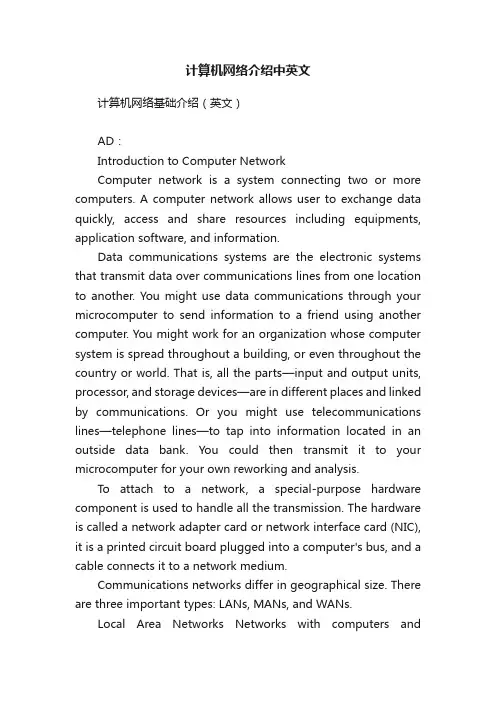
计算机网络介绍中英文计算机网络基础介绍(英文)AD:Introduction to Computer NetworkComputer network is a system connecting two or more computers. A computer network allows user to exchange data quickly, access and share resources including equipments, application software, and information.Data communications systems are the electronic systems that transmit data over communications lines from one location to another. You might use data communications through your microcomputer to send information to a friend using another computer. You might work for an organization whose computer system is spread throughout a building, or even throughout the country or world. That is, all the parts—input and output units, processor, and storage devices—are in different places and linked by communications. Or you might use telecommunications lines—telephone lines—to tap into information located in an outside data bank. You could then transmit it to your microcomputer for your own reworking and analysis.To attach to a network, a special-purpose hardware component is used to handle all the transmission. The hardware is called a network adapter card or network interface card (NIC), it is a printed circuit board plugged into a computer's bus, and a cable connects it to a network medium.Communications networks differ in geographical size. There are three important types: LANs, MANs, and WANs.Local Area Networks Networks with computers andperipheral devices in close physical proximity—within the same building, for instance—are called local area networks (LANs). Linked by cable-telephone, coaxial, or fiber optic. LANs often use a bus form organization. In a LAN, people can share different equipments, which lower the cost of equipments. LAN may be linked to other LANs or to larger networks by using a network gateway. With the gateway, one LAN may be connected to the LAN of another LAN of another office group. It may also be connected to others in the wide world, even if their configurations are different. Alternatively, a network bridge would be used to connect networks with the same configurations.There is a newly development for LANs: WLAN. A wireless LAN (WLAN) is a flexible data communication system implemented as an extension to, or as an alternative for, a wired LAN within a building or campus. Using electromagnetic waves, WLANs transmit and receive data over the air, minimizing the need for wired connections. Thus, WLANs combine data connectivity with user mobility, and, through simplified configuration, enable movable LANs.Over the recent several years, WLANs have gained strong popularity in a number of vertical markets, including the health-care, retail, manufacturing, warehousing, and academic arenas.These industries have profited from the productivity gains of using hand-held terminals and notebook computers to transmit real-time information to centralized hosts for processing. Today WLANs are becoming more widely recognized as a general-purpose connectivity alternative for a broad range of business customers.Applications for Wireless LANs Wireless LANs frequently augment rather than replace wired LAN networks—oftenproviding the final few meters of connectivity between a backbone network and the mobile user. The following list describes some of the many applications made possible through the power and flexibility of wireless LANs:●Doctors and nurses in hospitals are more productive because hand-held or notebook computers with wireless LAN capability deliver patient information instantly.●Consulting or accounting audit engagement teams or small workgroups increase productivity with quick network setup.●Network managers in dynamic environments minimize the overhead of moves, adds, and changes with wireless LANs, thereby reducing the cost of LAN ownership.●Training sites at corporations and students at universities use wireless connectivity to facilitate access to information, information exchanges, and learning.●Network managers installing networked computers in older buildings find that wireless LANs are a cost-effective network infrastructure solution.●Retail store owners use wireless networks to simply frequent network reconfiguration.●Trade show and branch office workers minimize setup requirements by installing preconfigured wireless LANs needing no local MIS support.●Warehouse workers use wireless LANs to exchange information with central databases and increase their productivity.●Network managers implement wireless LANs to provide backup for mission-critical applications running on wired networks.●Senior executives in conference rooms make quickerdecisions because they have real-time information at their fingertips.The increasingly mobile user also becomes a clear candidate for a wireless LAN. Portable access to wireless networks can be achieved using laptop computers and wireless NICs. This enables the user to travel to various locations–meeting rooms, hallways, lobbies, cafeterias, classrooms, etc.–and still have access to their networked data. Without wireless access, the user would have to carry clumsy cabling and find a network tap to plug into.Metropolitan Area Networks These networks are used as links between office buildings in a city. Cellular phone systems expand the flexibility of MAN by allowing links to car phones and portable phones.Wide Area Networks Wide area networks are countrywide and worldwide networks. Among other kinds of channels, they use microwave relays and satellites to reach users over long distances. One of the most widely used WANs is Internet, which allows users to connect to other users and facilities worldwide.计算机网络基础介绍(译文)计算机网络是连接两个或多个计算机的系统,它允许用户快速地交换数据,访问和共享包括设备、应用软件和信息在内的资源。
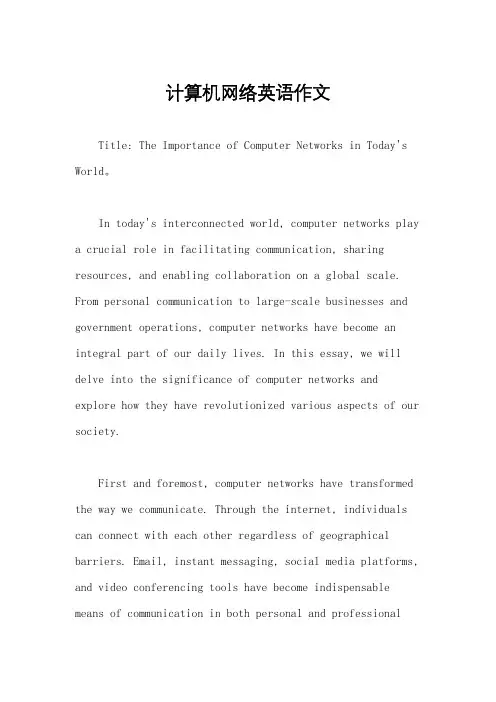
计算机网络英语作文Title: The Importance of Computer Networks in Today's World。
In today's interconnected world, computer networks play a crucial role in facilitating communication, sharing resources, and enabling collaboration on a global scale. From personal communication to large-scale businesses and government operations, computer networks have become an integral part of our daily lives. In this essay, we will delve into the significance of computer networks and explore how they have revolutionized various aspects of our society.First and foremost, computer networks have transformed the way we communicate. Through the internet, individuals can connect with each other regardless of geographical barriers. Email, instant messaging, social media platforms, and video conferencing tools have become indispensable means of communication in both personal and professionalsettings. This seamless exchange of information has greatly enhanced productivity and efficiency in various sectors.Moreover, computer networks facilitate the sharing and dissemination of information on a massive scale. Online platforms enable users to access vast repositories of knowledge, ranging from educational resources to entertainment content. The proliferation of online libraries, digital archives, and streaming services has democratized access to information, empowering individuals to learn and grow irrespective of their location or socioeconomic status.Furthermore, computer networks have revolutionized the way businesses operate. Through e-commerce platforms, companies can reach a global audience and conduct transactions seamlessly. Supply chain management systems rely on computer networks to coordinate the flow of goods and services efficiently. Moreover, cloud computing services offer businesses scalable and cost-effective solutions for storage, data processing, and software deployment. These technological advancements have not onlyimproved operational efficiency but also fostered innovation and entrepreneurship.In addition to enhancing communication and collaboration, computer networks play a crucial role in ensuring the security and integrity of data. With the proliferation of cyber threats, securing network infrastructure and safeguarding sensitive information have become paramount concerns for organizations and individuals alike. Encryption technologies, firewalls, and intrusion detection systems help mitigate risks and protect against unauthorized access and malicious activities. Moreover, ongoing research and development efforts are focused on enhancing cybersecurity measures to address emerging threats and vulnerabilities.Furthermore, computer networks have transformed the way we access and consume entertainment and media content. Streaming services, online gaming platforms, and social media networks have become ubiquitous forms of entertainment, offering users a diverse array of content at their fingertips. The advent of high-speed internetconnectivity has enabled seamless multimedia streaming, immersive gaming experiences, and real-time interaction with content creators and fellow users.Additionally, computer networks have revolutionized the field of healthcare by enabling telemedicine and remote patient monitoring. Patients can consult healthcare professionals, access medical records, and receive diagnoses and treatment recommendations remotely, eliminating the need for physical visits to healthcare facilities. This not only improves access to healthcare services, particularly in underserved areas, but also enhances patient convenience and reduces healthcare costs.In conclusion, computer networks have transformed the way we communicate, collaborate, conduct business, and access information and entertainment. From personal interactions to global transactions, computer networks have become the backbone of our interconnected world. However, it is essential to recognize the importance of ensuring the security and integrity of these networks to mitigate risks and safeguard against cyber threats. As technologycontinues to evolve, computer networks will undoubtedly play an even more significant role in shaping the future of our society.。

专业计算机网络简介英语作文English:Computer networks are an essential part of our modern world, enabling communication and data transfer between devices and users across the globe. As a professional field, computer networking involves the design, implementation, and management of networks, including local area networks (LANs), wide area networks (WANs), and the internet. This field encompasses a range of technologies and protocols, including Ethernet, TCP/IP, wireless networking, and network security. Professionals in this field work to ensure efficient and secure communication between devices, as well as the availability and reliability of network resources. Computer networking also plays a crucial role in supporting various industries and applications, such as e-commerce, telecommunication, online services, and cloud computing. The demand for skilled network professionals continues to grow as our reliance on technology and connectivity increases, making computer networking a valuable and dynamic field of study and practice.Translated content:计算机网络是我们现代世界的必要组成部分,它使得设备和用户在全球范围内能够进行通信和数据传输。
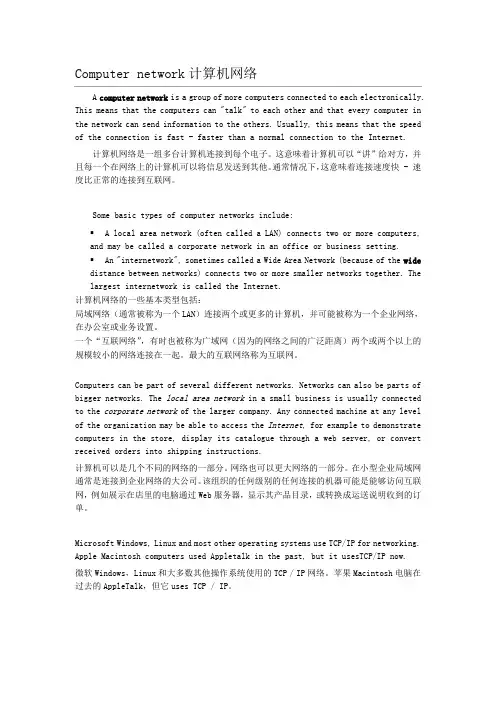
Computer network计算机网络A computer network is a group of more computers connected to each electronically. This means that the computers can "talk" to each other and that every computer in the network can send information to the others. Usually, this means that the speed of the connection is fast - faster than a normal connection to the Internet.计算机网络是一组多台计算机连接到每个电子。
这意味着计算机可以“讲”给对方,并且每一个在网络上的计算机可以将信息发送到其他。
通常情况下,这意味着连接速度快 - 速度比正常的连接到互联网。
Some basic types of computer networks include:▪ A local area network (often called a LAN) connects two or more computers, and may be called a corporate network in an office or business setting.▪An "internetwork", sometimes called a Wide Area Network (because of the wide distance between networks) connects two or more smaller networks together. The largest internetwork is called the Internet.计算机网络的一些基本类型包括:局域网络(通常被称为一个LAN)连接两个或更多的计算机,并可能被称为一个企业网络,在办公室或业务设置。
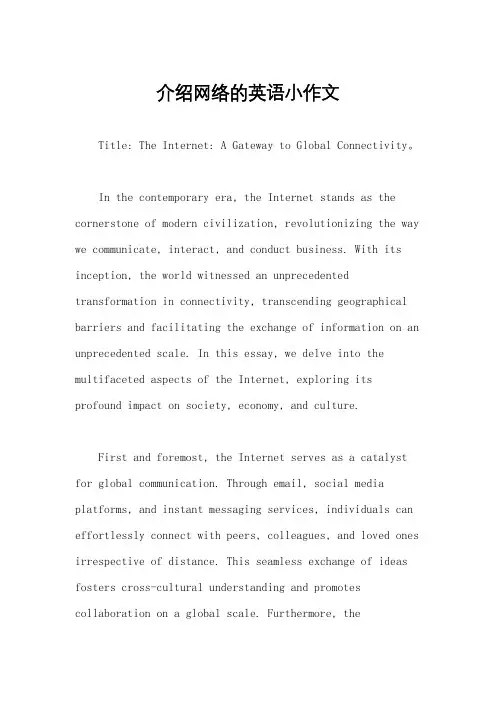
介绍网络的英语小作文Title: The Internet: A Gateway to Global Connectivity。
In the contemporary era, the Internet stands as the cornerstone of modern civilization, revolutionizing the way we communicate, interact, and conduct business. With its inception, the world witnessed an unprecedented transformation in connectivity, transcending geographical barriers and facilitating the exchange of information on an unprecedented scale. In this essay, we delve into the multifaceted aspects of the Internet, exploring its profound impact on society, economy, and culture.First and foremost, the Internet serves as a catalyst for global communication. Through email, social media platforms, and instant messaging services, individuals can effortlessly connect with peers, colleagues, and loved ones irrespective of distance. This seamless exchange of ideas fosters cross-cultural understanding and promotes collaboration on a global scale. Furthermore, theproliferation of video conferencing tools hasrevolutionized remote communication, enabling real-time interactions that transcend physical boundaries.Moreover, the Internet has democratized access to information, heralding an era of unprecedented knowledge dissemination. Through search engines and online libraries, individuals can access a wealth of information on virtually any topic with a few clicks. This democratization of knowledge empowers individuals to educate themselves, pursue lifelong learning, and stay abreast of global developments. Additionally, online educational platforms offer courses and tutorials, making quality education accessible to learners worldwide, regardless of their geographical location or socioeconomic status.Furthermore, the Internet has revolutionized the way businesses operate, ushering in the era of e-commerce and digital entrepreneurship. Online marketplaces provide a platform for businesses to reach a global audience, transcending the limitations of traditional brick-and-mortar stores. Moreover, digital marketing strategiesleverage data analytics and targeted advertising to reach specific demographics, maximizing the efficacy of promotional efforts. This digital transformation has not only streamlined business operations but has also created new avenues for innovation and entrepreneurship, driving economic growth and job creation.However, the ubiquity of the Internet also raises concerns regarding privacy, cybersecurity, and digital divide. As individuals increasingly rely on digital platforms for communication, entertainment, and commerce, safeguarding personal data and ensuring cybersecurity become paramount. Moreover, the digital divide exacerbates existing inequalities, with marginalized communities facing limited access to online resources and opportunities. Addressing these challenges requires concerted efforts from policymakers, businesses, and civil society to ensure that the benefits of the Internet are equitably distributed and that digital rights are protected.In conclusion, the Internet represents a paradigm shift in human connectivity, reshaping the way we communicate,learn, and conduct business. Its transformative impact spans across all facets of society, driving innovation, fostering global collaboration, and democratizing access to information. However, realizing the full potential of the Internet requires addressing challenges such as privacy, cybersecurity, and digital inequality. By harnessing the power of technology responsibly, we can leverage the Internet as a force for positive change, ushering in a more connected, inclusive, and prosperous world.。

中英文资料外文翻译计算机网络计算机网络,通常简单的被称作是一种网络,是一家集电脑和设备为一体的沟通渠道,便于用户之间的沟通交流和资源共享。
网络可以根据其多种特点来分类。
计算机网络允许资源和信息在互联设备中共享。
一.历史早期的计算机网络通信始于20世纪50年代末,包括军事雷达系统、半自动地面防空系统及其相关的商业航空订票系统、半自动商业研究环境。
1957年俄罗斯向太空发射人造卫星。
十八个月后,美国开始设立高级研究计划局(ARPA)并第一次发射人造卫星。
然后用阿帕网上的另外一台计算机分享了这个信息。
这一切的负责者是美国博士莱德里尔克。
阿帕网于来于自印度,1969年印度将其名字改为因特网。
上世纪60年代,高级研究计划局(ARPA)开始为美国国防部资助并设计高级研究计划局网(阿帕网)。
因特网的发展始于1969年,20世纪60年代起开始在此基础上设计开发,由此,阿帕网演变成现代互联网。
二.目的计算机网络可以被用于各种用途:为通信提供便利:使用网络,人们很容易通过电子邮件、即时信息、聊天室、电话、视频电话和视频会议来进行沟通和交流。
共享硬件:在网络环境下,每台计算机可以获取和使用网络硬件资源,例如打印一份文件可以通过网络打印机。
共享文件:数据和信息: 在网络环境中,授权用户可以访问存储在其他计算机上的网络数据和信息。
提供进入数据和信息共享存储设备的能力是许多网络的一个重要特征。
共享软件:用户可以连接到远程计算机的网络应用程序。
信息保存。
安全保证。
三.网络分类下面的列表显示用于网络分类:3.1连接方式计算机网络可以据硬件和软件技术分为用来连接个人设备的网络,如:光纤、局域网、无线局域网、家用网络设备、电缆通讯和G.hn(有线家庭网络标准)等等。
以太网的定义,它是由IEEE 802标准,并利用各种媒介,使设备之间进行通信的网络。
经常部署的设备包括网络集线器、交换机、网桥、路由器。
无线局域网技术是使用无线设备进行连接的。
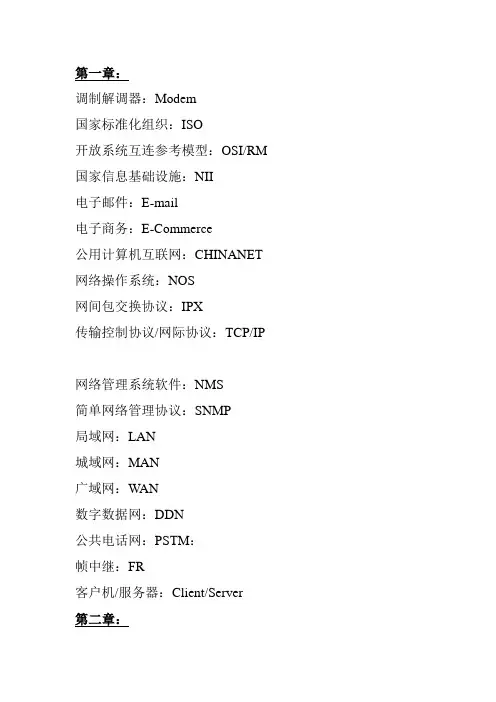
第一章:调制解调器:Modem国家标准化组织:ISO开放系统互连参考模型:OSI/RM 国家信息基础设施:NII电子邮件:E-mail电子商务:E-Commerce公用计算机互联网:CHINANET 网络操作系统:NOS网间包交换协议:IPX传输控制协议/网际协议:TCP/IP网络管理系统软件:NMS简单网络管理协议:SNMP局域网:LAN城域网:MAN广域网:WAN数字数据网:DDN公共电话网:PSTM:帧中继:FR客户机/服务器:Client/Server第二章:数据终端设备:DTE数据端接设备:DCE异步传输模式:ATM循环冗余码校验:CRC第三章:服务访问点:SAP数据终端设备:DTE数据电路终接设备:DCE美国电子工业协会:EIA虚拟终端:VT虚拟终端协议:VTP介质访问控制:MAC载波侦听多路访问:CSMA/CD逻辑链路控制:LLC介质连接单元:MAC集线器:Hub交换机:Swicth非屏蔽双绞线:UTP宽带综合业务数字:B-ISDN服务质量:QoS光纤分布数据接口:FDDI美国国防部高级研究计划署:ARPA网际控制报文协议:ICMP 地址解析协议:ARP逆向地址解析协议:RARP 传输控制协议:TCP用户数据报协议:UDP文件传输协议:FTP远程登录协议:Telnet简单邮件传输协议:SMTP 超文本传输协议HTTP路由信息协议:RIP域名服务:DNS公共交换电话网:PSTN综合业务数字网:ISDN数字数据网:DDN点对点协议:PPP帧中继:FR第四章:非屏蔽双绞线:UTP屏蔽双绞线:STP国际电气工业协会:EIA 光纤插座:FJ发光二极管:LED注入型激光二极管:ILD单模光纤:SMF多模光纤:MMF第五章:网卡:NIC网桥:Bridge交换机:Switch虚拟局域网:VLAN服务质量:QoS路由选择信息协议:RIP内部网关路由协议:IGRPInternet接入访问提供商:ISP中继器:RP第六章:美国国防部高级研究计划局:ARPA 美国国家科学基金会:NSF国家信息基础设施:NII中国公用计算机互联网:CHINANET 中国科技网:CSTNET中国教育和科研计算机网:CERNET 中国金桥网:CHINAGBN简单邮件传输协议:SMTP邮局传输协议:POP3网络虚拟终端:NVT万维网:WWW统一资源定位器:URL超文本标记语言:HTML即时通讯:IM超文本传输协议:HTTP国家科学基金会:NSFNET Tnternet网络信息中心:NIC “与”:AND域名服务:DNS国际互联网络信息中心:TnterNIC 中国互联网络信息中心:CNNIC ISDN配适器:TA虚拟私有网络:VPN非对称数字用户线:ADSL第七章:控制报文协议:ICMP网络管理系统:NMS管理信息库:MIB远程监控:RMON黑客:Hacker防火墙:Firewall第八章:家庭网络:SOHO计算机局域网络:WLAN 介质存取控制层:MAC。
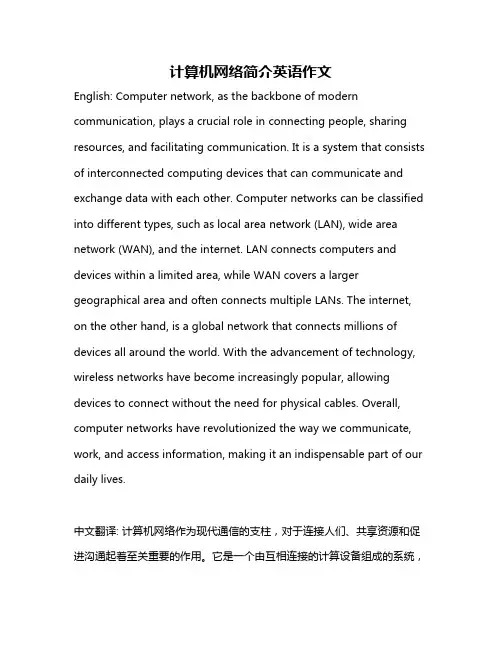
计算机网络简介英语作文English: Computer network, as the backbone of modern communication, plays a crucial role in connecting people, sharing resources, and facilitating communication. It is a system that consists of interconnected computing devices that can communicate and exchange data with each other. Computer networks can be classified into different types, such as local area network (LAN), wide area network (WAN), and the internet. LAN connects computers and devices within a limited area, while WAN covers a larger geographical area and often connects multiple LANs. The internet, on the other hand, is a global network that connects millions of devices all around the world. With the advancement of technology, wireless networks have become increasingly popular, allowing devices to connect without the need for physical cables. Overall, computer networks have revolutionized the way we communicate, work, and access information, making it an indispensable part of our daily lives.中文翻译: 计算机网络作为现代通信的支柱,对于连接人们、共享资源和促进沟通起着至关重要的作用。
计算机网络简介英语作文Introduction to Computer Networks.In today's world, computer networks have become an integral part of our lives, connecting people, devices, and information across vast distances. These networks enable seamless communication, information sharing, and collaboration, powering everything from personal email to global businesses and research institutions.1. Definition of Computer Networks.Computer networks are interconnected collections of devices that can exchange data and share resources. These devices can range from personal computers and laptops to servers, routers, switches, and even mobile phones and tablets. Networks can be classified based on their size, topology, and purpose.2. Types of Computer Networks.Local Area Networks (LANs): These are networks that cover a small geographical area, such as an office building or a school campus. LANs typically connect computers and devices within a close proximity, enabling fast andefficient data transfer.Wide Area Networks (WANs): WANs span a much larger geographical area, connecting LANs or other networks across cities, states, or even countries. The internet is an example of a global WAN.Metropolitan Area Networks (MANs): These networkscover a geographical area larger than a LAN but smallerthan a WAN, typically connecting multiple buildings or locations within a city or metropolitan region.Personal Area Networks (PANs): PANs connect devices within a personal space, such as a room or on a person's body. They are commonly used for wireless communication between devices like smartphones, headphones, and wearables.3. Components of Computer Networks.Hardware: This includes devices like computers, routers, switches, servers, and cables that form the physical infrastructure of the network.Software: Network software manages and controls the flow of data, enabling devices to communicate with each other effectively.Protocols: Protocols define the rules and formats for data communication on the network. They ensure that devices can understand and interpret the information being transmitted.4. Functions of Computer Networks.Data Communication: Networks enable the transmission of data between devices, allowing users to send and receive emails, access websites, or share files.Resource Sharing: Networks allow devices to access andshare resources like printers, scanners, and servers.Distributed Processing: By dividing tasks between multiple devices, networks can improve processing speed and efficiency.Information Retrieval: Networks provide access to vast repositories of information, enabling users to search and retrieve information from various sources.5. Technologies Used in Computer Networks.Wired vs. Wireless: Networks can be wired, using cables to connect devices, or wireless, using radio waves for communication. Wireless networks, such as Wi-Fi and Bluetooth, provide greater flexibility and convenience.Networking Protocols: Protocols like TCP/IP, HTTP, SMTP, and FTP govern how devices communicate with each other on the network.Networking Hardware: Routers, switches, servers, andfirewalls are essential hardware components that enable network connectivity, manage traffic, and provide security.6. Security Considerations in Computer Networks.With the increasing interconnectedness of computer networks, security has become a paramount concern. Measures like firewalls, antivirus software, and encryption techniques are used to protect networks from unauthorized access, data breaches, and malicious attacks.Conclusion.Computer networks have revolutionized the way we live and work, connecting people and resources across the globe. Understanding the basics of computer networks is crucial in today's interconnected world, as it enables us to leverage their power and address the challenges posed by ever-evolving technologies and security threats.。
计算机⺴⽹网络关键字英⽂文中⽂文对照第⼀一章-协议(Protocol)-⺴⽹网络边缘(Network Edge)-有线⺴⽹网络,⽆无线⺴⽹网络(wired,wireless communication links )-拨号调制解调器(dial-up Modem)-数字⽤用户线(digit subscriber line,DSL)-电缆调制解调器(cable modem)-混合光纤同轴电缆(hybrid fiber coax,HFC)-双绞线(Twisted Pair)-同轴电缆(Coaxial cable)-光缆(Fiber optic cable)-电路交换(circuit switching)-分组交换(packet switching)-端到端连接(end-to-end connection)-频分多路复⽤用(Frequency-Division Multiplexing,FDM)-时分多路复⽤用(Time-Division Multiplexing,TDM)-统计多路复⽤用(statistical multiplexing)-第⼀一层ISP(tier-1 ISP)-时延(delay)、节点处理时延(nodal processing delay)、排队时延(queuing delay)、传输时延(transmission delay)、传播时延(propagation delay)、节点总时延(total nodal delay)-丢包(package loss)-吞吐量(Troughput)-应⽤用层(application layer)、表⽰示层(presentation)、会话层(session)、传输层(transport layer)、⺴⽹网络层(network layer)、链路层(link layer)、物理层(physical layer)-报⽂文(message)、报⽂文段(segment)、数据报(datagram)、帧(frame)-HTTP——Hyper-Text Transfer Protocol-FTP——File Transfer Protocol-SMTP——Simple Mail Transfer Protocol-DNS——Domain Name Service-TCP——Transmission Control Protocol•⾯面向连接——Connection-Oriented(三次握⼿手)•数据可靠——Reliable data transport•拥塞控制——Congestion Control——抑制发送进程•流量控制——Flow Control•如email(SMTP)、远程终端访问(Telnet)、Web(HTTP)、⽂文件传输(FTP)、流媒体(HTTP、RTP)⺴⽹网络层使⽤用TCP协议-UDP——User Datagram Protocol•不可靠数据传输服务•如流媒体(HTTP、RTP)、因特⺴⽹网电话(SIP、RTP)通常⺴⽹网络层使⽤用UDP-IP——Internet Protocol-⽊木⻢马(Trojan horse)、病毒(Virus)、蠕⾍虫(Worm)、DDoS(Distributed Deny of Service)第⼆二章应⽤用层-客户机-服务器(Client-Server)、P2P-client process :process that initiates communication-server process:Process that waits to be contacted-套接字(Socket)-传输层协议提供的服务•Reliable data transfer•Throughput•Timing•Security-HTTP•⽆无状态协议(stateless)•⾮非持久连接、短连接(non-persistent connection)•持久连接、⻓长连接(persistent connection)•pull protocol-往返时间(Round-Trip Time,RTT)-Cookie-server agent-SMTP•push protocol-多⽤用途因特⺴⽹网邮件扩展(Multipurpose Internet Mail Extension,MIME)-DNS•运⾏行在UDP上,使⽤用53号端⼝口•规范和别名•负载分配•主机名->IP地址转换-P2P•直接在对等⽅方传输•⾼高度的可拓展能⼒力•使⽤用客户机-服务器模型第三章运输层-逻辑通信(logical communication)-多路复⽤用(transport-layer multiplexing)与多路分解(demultiplexing)-源端⼝口号字段(source port number field)-⺫⽬目的端⼝口号字段(destination port number field)-周知端⼝口号(well-known port number)-Reliability data transport•完全可靠信道上的可靠数据传输 rdt1.0•具有⽐比特差错信道上的可靠数据传输 rdt2.0——stop-wait protocol•具有⽐比特差错的丢包信道上的可靠数据传输 rdt3.0——alternating-bit protocol•流⽔水线可靠数据协议-Go-Back_N——窗⼝口⼤大⼩小最⼤大2^k-1-选择性重传(selection repeat)窗⼝口⼤大⼩小最⼤大2^(k-1)-拥塞控制(congestion control)-流量控制(flow control)-第四章-转发(forwarding)-选路(routing)-虚电路(Virtual-Circuit,VC)⺴⽹网络:仅在⺴⽹网络层提供连接服务的计算机⺴⽹网络,如ATM、帧中继。
计算机网络技术英语作文英文回答:Computer networking is a rapidly evolving field thathas revolutionized the way we communicate, share information, and access resources. With the advent of the Internet, computer networks have become an essential partof our daily lives, enabling global connectivity,information dissemination, and collaboration on an unprecedented scale.The fundamental components of a computer networkinclude computers, networking devices (such as routers and switches), and communication media (such as cables or wireless connections). These components are interconnectedto form a network topology, which defines the physical and logical layout of the network. Different network topologies, such as star, bus, and ring topologies, have varying advantages and disadvantages, and the choice of topology depends on factors such as network size, performancerequirements, and cost.Data transmission over computer networks is governed by a set of protocols that define how data is formatted, addressed, transmitted, and received. The most widely used protocol suite is the Internet Protocol Suite (TCP/IP), which provides a reliable and efficient framework for communication across different types of networks. TCP/IP consists of several layers, each with its own specific responsibilities, such as data encapsulation, routing, and error checking.Network security is of paramount importance in protecting data from unauthorized access and attacks. Various security measures are employed to safeguard networks, including firewalls, intrusion detection systems, encryption, and authentication mechanisms. Network security best practices involve regularly updating software, implementing strong passwords, and conducting security audits to identify and mitigate vulnerabilities.Computer networks have had a profound impact on varioussectors, including education, healthcare, business, and entertainment. In education, computer networks facilitate remote learning, provide access to vast online educational resources, and enable collaboration among students and educators. In healthcare, computer networks allow for electronic health records, telemedicine, and remote monitoring of patients. In business, computer networks enable seamless communication and collaboration among employees, enhance efficiency through automation, and facilitate e-commerce. In entertainment, computer networks provide access to streaming services, online gaming, and social networking platforms.As technology continues to advance, computer networks will continue to evolve and play an even more integral role in our lives. The rise of mobile computing, cloud computing, and the Internet of Things (IoT) is driving the development of new network architectures and technologies to meet the increasing demands for connectivity, bandwidth, and security.中文回答:计算机网络技术。
计算机网络技术英语作文【中英文版】Composition on Computer Network TechnologyIn the realm of contemporary society, computer network technology plays an indispensable role, permeating every facet of our lives.The magic of this digital era is woven into the fabric of our daily routines, from the moment we wake up and check our smartphones to the seconds before we fall asleep, scrolling through social media feeds.在当今社会领域,计算机网络技术发挥着不可或缺的作用,渗透我们生活的每一个角落。
这个数字时代的魔力,从我们早晨醒来检查智能手机的那一刻,到入睡前在社交媒体上刷屏的瞬间,编织进了我们日常生活的方方面面。
The internet, a global network of interconnected devices, has transformed the way we communicate, learn, and conduct business.Email has revolutionized the postal system, video conferencing has made geographical boundaries negligible, and e-commerce has reshaped the retail landscape.互联网,这个全球互联设备的网络,改变了我们沟通、学习和开展业务的方式。
有关计算机网络的英文作文English:Computer networks play a crucial role in our modern world, connecting devices and allowing for the exchange of information globally. The structure of a computer network typically consists of nodes, such as computers or servers, connected by communication links, enabling data to be transmitted efficiently. There are different types of computer networks, including LANs (Local Area Networks), MANs (Metropolitan Area Networks), and WANs (Wide Area Networks), with each designed to cater to specific needs and requirements. The advancements in networking technology have led to faster and more reliable connections, with the emergence of concepts such as cloud computing and the Internet of Things further expanding the capabilities of computer networks. Security concerns, however, remain a significant issue for networks, with measures such as firewalls, encryption, and authentication protocols being implemented to protect data and prevent unauthorized access. Overall, computer networks have revolutionized the way we communicate and access information, playing a vital role in our interconnected world.Translated content:计算机网络在我们现代世界中扮演着至关重要的角色,连接设备并允许在全球范围内交换信息。
计算机网络技术英语介绍Computer Networking is a field that encompasses a wide range of technologies and principles that allow different devices to communicate with each other over a shared medium. The technology has revolutionized the way we share information and collaborate, making it possible to access data and services from anywhere in the world. This introduction will provide an overview of the key concepts and components of computer networking in English.Fundamentals of Computer NetworkingComputer networking is based on a set of protocols that define how data is transmitted and received between devices. The most fundamental protocol suite is the Internet Protocol Suite, commonly known as TCP/IP, which is the foundation of the internet.- Protocols: A protocol is a set of rules governing the format and transmission of data. Protocols define everything from the physical wiring and signal transmission to the high-level data formats used for specific applications.- IP Addressing: Every device connected to a network has a unique identifier known as an IP address. This address is used to route data packets to and from the device.- Data Packets: Data is divided into smaller units calledpackets, which are transmitted over the network and then reassembled at the destination.Network TopologiesThe physical and logical layout of devices in a network is known as a topology. Common topologies include:- Bus Topology: All devices are connected to a single cable, with messages broadcast to all devices.- Star Topology: Devices are connected to a central hub, with each device communicating through the hub.- Ring Topology: Devices are connected in a circular fashion, with data passing from one device to the next in a sequential manner.Network DevicesVarious devices are used to construct and manage networks:- Routers: Connect different networks and forward data packets between them based on their IP addresses.- Switches: Connect devices within a network, directing data to the correct destination.- Hubs: Similar to switches but without the ability to direct data to specific devices, instead broadcasting to all connected devices.- Modems: Convert digital data into analog signals for transmission over telephone lines or other types of transmission media.Types of NetworksNetworks can be classified based on their size and scope:- LAN (Local Area Network): Connects devices within a small area, such as a home, office, or school.- WAN (Wide Area Network): Covers a larger geographical area, often connecting multiple LANs.- MAN (Metropolitan Area Network): Spans a larger area than a LAN but smaller than a WAN, typically a city or town.Wireless NetworkingThe advent of wireless networking has significantly expanded the reach and flexibility of computer networks:- Wi-Fi: A popular wireless networking technology that allows devices to connect to a network wirelessly within a certain range.- Bluetooth: A short-range wireless technology used for connecting devices over small distances.Cybersecurity in NetworkingAs networks become more interconnected, the importance of cybersecurity grows:- Firewalls: Security devices that monitor and control incoming and outgoing network traffic based on predetermined security rules.- Encryption: The process of encoding messages or informationto ensure secure communication and prevent unauthorized access.Future of NetworkingThe future of networking is likely to involve further developments in areas such as:- 5G Technology: The next generation of mobile networks, promising faster speeds and lower latency.- IoT (Internet of Things): The interconnection of everyday objects, allowing them to send and receive data.- SDN (Software-Defined Networking): A networkingarchitecture that allows network administrators to manage network services through software applications.In conclusion, computer networking is a dynamic and essential field that continues to evolve with technological advancements. Understanding the basics of networking is crucial for anyone working in the technology sector or for those who wish to stay informed about the infrastructure that underpins our increasingly digital world.。
计算机网络基础介绍(英文)AD:Introduction to Computer NetworkComputer network is a system connecting two or more computers. A computer network allows user to exchange data quickly, access and share resources including equipments, application software, and information.Data communications systems are the electronic systems that transmit data over communications lines from one location to another. You might use data communications through your microcomputer to send information to a friend using another computer. You might work for an organization whose computer system is spread throughout a building, or even throughout the country or world. That is, all the parts—input and output units, processor, and storage devices—are in different places and linked by communications. Or you might use telecommunications lines—telephone lines—to tap into information located in an outside data bank. You could then transmit it to your microcomputer for your own reworking and analysis.To attach to a network, a special-purpose hardware component is used to handle all the transmission. The hardware is called a network adapter card or network interface card (NIC), it is a printed circuit board plugged into a computer's bus, and a cable connects it to a network medium.Communications networks differ in geographical size. There are three important types: LANs, MANs, and WANs.Local Area Networks Networks with computers and peripheral devices in close physical proximity—within the same building, for instance—are called local area networks (LANs). Linked by cable-telephone, coaxial, or fiber optic. LANs often use a bus form organization. In a LAN, people can share different equipments, which lower the cost of equipments. LAN may be linked to other LANs or to larger networks by using a network gateway. With the gateway, one LAN may be connected to the LAN of another LAN of another office group. It may also be connected to others in the wide world, even if their configurations are different. Alternatively, a network bridge would be used to connect networks with the same configurations.There is a newly development for LANs: WLAN. A wireless LAN (WLAN) is a flexible data communication system implemented as an extension to, or as an alternative for, a wired LAN within a building or campus. Using electromagnetic waves, WLANs transmit and receive data over the air, minimizing the need for wired connections. Thus, WLANs combine data connectivity with user mobility, and, through simplified configuration, enable movable LANs.Over the recent several years, WLANs have gained strong popularity in a number of vertical markets, including the health-care, retail, manufacturing, warehousing, and academic arenas.These industries have profited from the productivity gains of using hand-held terminals and notebook computers to transmit real-time information to centralized hosts for processing. Today WLANs are becoming more widely recognized as a general-purpose connectivity alternative for a broad range of business customers.Applications for Wireless LANs Wireless LANs frequently augment rather than replace wired LAN networks—often providing the final few meters of connectivity between a backbone network and the mobile user. The following list describes some of the many applications made possible through the power and flexibility of wireless LANs:●Doctors and nurses in hospitals are more productive because hand-held or notebook computers with wireless LAN capability deliver patient information instantly.●Consulting or accounting audit engagement teams or small workgroups increase productivity with quick network setup.●Network managers in dynamic environments minimize the overhead of moves, adds, and changes with wireless LANs, thereby reducing the cost of LAN ownership.●Training sites at corporations and students at universities use wireless connectivity to facilitate access to information, information exchanges, and learning.●Network managers installing networked computers in older buildings find that wireless LANs are a cost-effective network infrastructure solution.●Retail store owners use wireless networks to simply frequent network reconfiguration.●Trade show and branch office workers minimize setup requirements by installing preconfigured wireless LANs needing no local MIS support.●Warehouse workers use wireless LANs to exchange information with central databases and increase their productivity.●Network managers implement wireless LANs to provide backup for mission-critical applications running on wired networks.●Senior executives in conference rooms make quicker decisions because they have real-time information at their fingertips.The increasingly mobile user also becomes a clear candidate for a wireless LAN. Portable access to wireless networks can be achieved using laptop computers and wireless NICs. This enables the user to travel to various locations–meeting rooms, hallways, lobbies, cafeterias, classrooms, etc.–and still have access to their networked data. Without wireless access, the user would have to carry clumsy cabling and find a network tap to plug into.Metropolitan Area Networks These networks are used as links between office buildings in a city. Cellular phone systems expand the flexibility of MAN by allowing links to car phones and portable phones.Wide Area Networks Wide area networks are countrywide and worldwide networks. Among other kinds of channels, they use microwave relays and satellites to reach users over long distances. One of the most widely used WANs is Internet, which allows users to connect to other users and facilities worldwide.计算机网络基础介绍(译文)计算机网络是连接两个或多个计算机的系统,它允许用户快速地交换数据,访问和共享包括设备、应用软件和信息在内的资源。